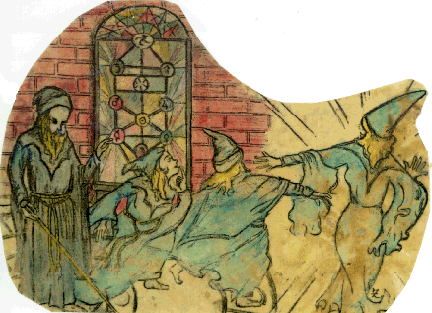|
Kabbalah Study: Magic Magic is early scienceBy Rob Zucker
Much of what we have accomplished today- telephone, television, wireless, automobiles, airplanes and electricity - would have been considered acts of magic a few hundred years ago. Today, we call it technology. Magic is the act of "causing change of occur in conformity with Will," according to Aleister Crowley the famed magickian of the early 20th century. Every act is a magical act. Magic becomes occult when it is not understood how the event occured. Forcing the tree to turn into a chair is the work of a carpenter. Forcing nature to change its course, like making its rain on a sunny day, is through the will of the magician. Early humans tried to alter their surroundings and control nature through ceremonial acts or rituals. Some of those ceremonies still exist today in the form of holidays like Halloween, Christmas and Hanukkah. Science, religion and magic rest on the priniciples that the uiverse is controlled by natural forces and the application of certain knowledge can bring about amazing effects- magic, miracles or technology. |
MAGICIn reality, magic is a sacred science. It is, in the very true sense the sum of all knowledge because it teaches how to utilize sovereign rules."- Franz BardonAstral Projection: Living inside your dreamsVirtualQBL Kabbalah software. Study Sefer Yetzirah digitally.Kabbalah Index
|
|||||
Playing god with magicAs humans first became aware of the power of natural forces in the universe - air, water, earth, and fire - those elements were equated with Archetypal images- "gods." There was the god of air, god of water, god of fire, and so on. The gods were in control of nature- the universe. When religion evolved from pagan worship, the study of those forces of nature became theoretical and practical science. The study of air is today's aerodynamics and how to fly like birds in airplanes and rocketships. The study of fire evolved in learning how to harness its power to cook, provide light in darkness, heat in the cold. The control over water gave us irrigation, electricity and help spawn civilization. The gods had to share the forces of nature with the early scientists. But before there were spacecraft, TV's, iPads, electricity, before printed books and running water, the forces of nature were controlled through ritual, magical spells and ceremonial magic. Magic, science and religion all depend on strict conditions, and ceremonies, or achieve their goal. If any one of the prescribed rites are neglected (forget to pronouce a proper name of a spirit or failure to properly land a plane), the desired effect will be evident in its results (you insult your diety or crash your plane). The Kabbalah is magicAs civilization evolved, magic, science and religion took different routes to explain the same principles. Kabbalah, the study of the mystical aspects of the universe, developed to bridge the gap between religion and magic. Science tried to prove the existence of both. Learn more about the study of Kabbalah.
Kabbalah Home Page | Kabbalah ShoppeEntertainment Magazine
|
Most popular and reliable books about MagicThese are the most popular books on magic, mysticism and magick. All of them can be purchased through these links at Amazon.com. Check for free shipping eligibility on some books.
|
 Humans
have learned that by following certain universal principles- then
expanding on those concepts- the environment can be altered.
Humans
have learned that by following certain universal principles- then
expanding on those concepts- the environment can be altered.